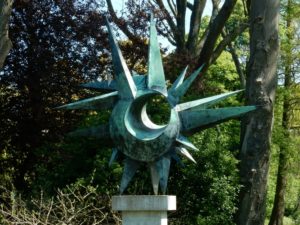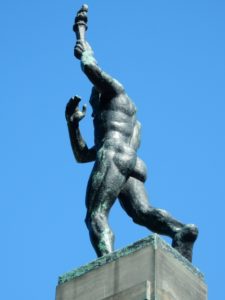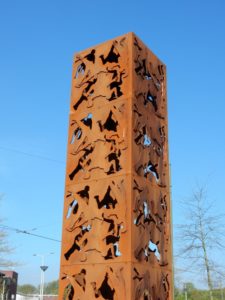
I consider myself an observant inhabitant of The Hague. But sometimes I find that I have been cycling past beautiful and interesting art without noticing it. So this time I show you the art at Zuiderpark.
Art in Zuiderpark: how it started

Have you visited the vast floral gardens at Keukenhof, in Lisse? Well, from April 9 to June 2 1941 Hagenaars enjoyed their own “Keukenhof”. This was a splendid display of floral colour and art, titled “Bloemen en Beelden’ (‘Flowers and Statues’) laid out in the city’s Zuiderpark, which was then not five years old.

An estimated 500,000 flower bulbs were planted in large borders in several colour schemes. After paying the entrance fee of ƒ 0,10 per person or ƒ 0,25 per family, visitors could admire 90 statues by well-known artists. Of course the Dutch currency at the time was guilders, hence the ƒ-sign for florins, the ancient word for guilders.
Statues today
Two of the 90 statues displayed in 1941 are still to be found in Zuiderpark. You can spot them in the beautiful colour film of the exhibition, kept in the archives.

The other statues now in Zuiderpark have different origins. Several, including the statues at each of the park entrances, were specifically commissioned for these prominent park locations. At the main entrance at Veluweplein stand a male figure, symbolizing victory and a female figure symbolizing speed.

During the 1950’s these statues were nicknamed Adam and Eve. After school hours local youth gathered at the park entrance — boys below Adam, girls below Eve.
Other statues were originally sited elsewhere in The Hague. I can still remember vividly the pieces of fruit lying on the lawn in front of the Leyenburg hospital (now known as HAGA Hospital Location Leyweg).

The artist Phil van de Klundert made these artworks large enough for patients to recognize them from the top floors of the hospital. Of this fruit basket only the banana remains and you can admire it lying in the green grass of Zuiderpark.
Zuiderpark provides a safe haven for statues, and because of that it has been nicknamed the “orphan park”. But orphans mature and leave the orphanage. Similarly, over the years, statues that once stood in Zuiderpark have been relocated to the city centre or other areas of The Hague. An organization called Stroom The Hague plays a vital role in the management of art in our city’s public environment.
The team behind the route

The Collection Escamp Team (Collectie Escamp Team) is a group of active and dedicated residents of the Escamp district (in which Zuiderpark is located). Their aim is to bring monumental art to the attention of others living in this district — and to residents of The Hague at large! As self-appointed guardians of the park’s monuments, they notify the local authorities if a work of art is weathered or damaged by vandalism. The Team also develops and promotes cycling and walking routes that highlight monuments and architecture throughout the Escamp District. You can find these routes on their website.

During all my city walks and cycling tours I point out statues and other details.


